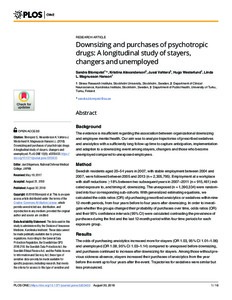Downsizing and purchases of psychotropic drugs: A longitudinal study of stayers, changers and unemployed
Blomqvist S; Hanson LLM; Alexanderson K; Vahtera J; Westerlund H
Downsizing and purchases of psychotropic drugs: A longitudinal study of stayers, changers and unemployed
Blomqvist S
Hanson LLM
Alexanderson K
Vahtera J
Westerlund H
PUBLIC LIBRARY SCIENCE
Julkaisun pysyvä osoite on:
https://urn.fi/URN:NBN:fi-fe2021042719650
https://urn.fi/URN:NBN:fi-fe2021042719650
Tiivistelmä
Background: The evidence is insufficient regarding the association between organizational downsizing and employee mental health. Our aim was to analyze trajectories of prescribed sedatives and anxiolytics with a sufficiently long follow-up time to capture anticipation, implementation and adaption to a downsizing event among stayers, changers and those who become unemployed compared to unexposed employees.MethodSwedish residents aged 20-54 years in 2007, with stable employment between 2004 and 2007, were followed between 2005 and 2013 (n = 2,305,795). Employment at a workplace with staff reductions >= 18% between two subsequent years in 2007-2011 (n = 915,461) indicated exposure to, and timing of, downsizing. The unexposed (n = 1,390,334) were randomized into four corresponding sub-cohorts. With generalized estimating equations, we calculated the odds ratios (OR) of purchasing prescribed anxiolytics or sedatives within nine 12-month periods, from four years before to four years after downsizing. In order to investigate whether the groups changed their probability of purchases over time, odds ratios (OR) and their 95% confidence intervals (95% CI) were calculated contrasting the prevalence of purchases during the first and the last 12-month period within four time periods for each exposure group.ResultsThe odds of purchasing anxiolytics increased more for stayers (OR 1.03, 95% CI 1.01-1.06) and unemployed (OR 1.08, 95% CI 1.03-1.14) compared to unexposed before downsizing, and purchases continued to increase after downsizing for stayers. Among those without previous sickness absence, stayers increased their purchases of anxiolytics from the year before the event up to four years after the event. Trajectories for sedatives were similar but less pronounced.ConclusionThis study indicates that being exposed to downsizing is associated with increased use of sedatives and anxiolytics, especially before the event, if the employee stays in the organization or becomes unemployed.
Kokoelmat
- Rinnakkaistallenteet [19207]
